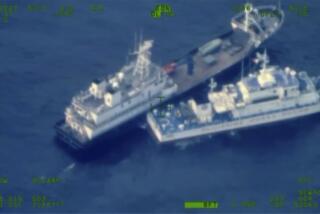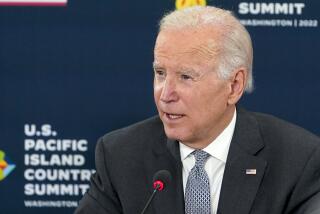THE MALTA SUMMIT : Bush Vows to Maintain U.S. Aid to Aquino
- Share via
VALLETTA, Malta — President Bush, responding to the crisis in the Philippines on Friday even as he moved toward his first summit meeting with Soviet President Mikhail S. Gorbachev, vowed to continue American aid to the embattled government of President Corazon Aquino.
“I strongly support Mrs. Aquino and she knows it,” Bush said, as U.S. officials expressed “cautious optimism” that the Philippine leader had survived the most serious assault thus far on her government by restive military officers.
Bush, speaking to reporters shortly after arriving here, said his decision to provide U.S. air cover for troops loyal to Aquino was justified by the need to defend a democratically elected government. “We’re doing what has been requested of us,” he said.
White House aides later added that protection of American lives was another major factor in the decision. They noted the presence of 106,000 U.S. citizens in the Manila region alone, with thousands more in other parts of the country, many of them U.S. armed forces and civilian personnel attached to the huge American air and naval bases in the Philippines.
Bush arrived in Malta, where he and Gorbachev will hold two days of summit meetings, looking drawn, clearly tired after a nine-hour transatlantic flight during which he was awakened at least twice to deal with developments in the Philippines.
After landing, he traveled to the 16th-Century Knights of Malta castle for a ceremonial greeting from Prime Minister Eddie Fenech Adami. Even there, Bush was interrupted by aides briefing him on Philippine developments.
The unfolding crisis not only disrupted the President’s pre-summit schedule but also posed a special challenge for an Administration stung earlier this fall by criticism of its seemingly disorganized response to the abortive coup attempt in Panama.
Since then, the Administration’s foreign policy crisis management structure has been reworked--”fine-tuned,” in the words of White House spokesman Roman Popadiuk. As a result, he said, even though Bush and Secretary of State James A. Baker III were on Air Force One en route here and Defense Secretary Dick Cheney had just returned to Washington from NATO meetings in Europe, this time, “the process worked extremely well under very difficult circumstances.”
Nonetheless, despite the apparent success, Administration officials were clearly discomfited by the degree to which the Philippine fighting overshadowed Bush’s arrival here, which was already in danger of being eclipsed by Gorbachev’s dramatic meeting with Pope John Paul II at the Vatican.
Until officials grew confident that Aquino’s side had begun to prevail, White House press officials here referred inquiries about the crisis to Washington in an apparent attempt to distance Bush from the story.
Crisis Management
Later in the day, as news from the Philippines improved, White House officials began releasing details of how the Administration was handling the crisis. But they also took pains to detail Bush’s final briefings on the Gorbachev meetings, insisting to reporters that despite the distractions of a distant war, the President was fully prepared for today’s negotiations aboard the Soviet cruiser Slava.
The Administration’s handling of the Philippine uprising contrasted sharply with its actions during the Panama coup attempt. During that affair, when the United States provided limited and seemingly ineffectual backing to Panamanian officers seeking to overthrow strongman Gen. Manuel A. Noriega, key information about events failed to reach Bush and his senior advisers in an organized and timely manner, a top-level Administration review later concluded.
And although Administration officials insist that better information would not have changed their decisions, nor the outcome of events in Panama, they decided in the wake of the coup’s failure to restructure the information process.
The chief reform was to strengthen the role of a panel known as a “deputies committee,” made up of the senior aide to each of the President’s top national security advisers and chaired by Deputy National Security Adviser Robert M. Gates.
That panel is now supposed to serve as a crisis management team, collecting information, analyzing options and preparing recommendations for Bush, Baker, Cheney and National Security Adviser Brent Scowcroft.
Through Thursday night and on into Friday morning, that panel met to arrange support for Aquino.
The crisis began to unfold at an awkward time for Bush: Washington was notified of the details of the developing coup at roughly 5:30 p.m. Thursday, barely more than an hour before the President’s scheduled departure for the Mediterranean. Over the next seven hours, officials met repeatedly to analyze the situation and prepare options for Bush, who ultimately approved the decision to deploy the Air Force at about 12:30 a.m. Friday.
According to a chronology of Administration actions provided by senior Administration officials, the crisis management team first met at the White House at 6:30 p.m. Thursday, as Bush’s helicopter was lifting off from the White House lawn en route to Andrews Air Force Base. At the same time, Gen. Colin L. Powell, chairman of the Joint Chiefs of Staff, convened his top aides at the Pentagon’s National Military Command Center to begin analyzing military options.
Gates’ group met for three hours, keeping in touch with Air Force One by telephone. But then, with no word from the Philippines and no request from Aquino for help, the committee went into recess.
Call to Aquino
At just that moment, however, Aquino and Philippine Defense Secretary Fidel V. Ramos were contacting U.S. Ambassador Nicholas Platt in Manila, asking for U.S. air support to immobilize mutinous elements of the Philippine air force at two bases outside the capital. Gates, an official said, received word of Platt’s request just as he arrived home shortly after 10 p.m. and hurriedly returned to the White House. He was quickly joined by other senior officials.
By 11 p.m. Gates’ team had reconvened and updated Bush on Aquino’s request. At 11:30 p.m., Vice President Dan Quayle, joined by Deputy Secretary of State Laurence S. Eagleburger, CIA chief William H. Webster, Gates and Deputy White House Chief of Staff Andrew Card, convened a senior-level meeting in the White House Situation Room and, after a 45-minute discussion, recommended to Bush that the request be approved.
Quayle then called Aquino, reaching her at about 1:30 a.m. Washington time. At the same time, the vice president called three congressional leaders, House Speaker Thomas S. Foley (D-Wash.), Senate Majority Leader George J. Mitchell (D-Maine) and House Minority Leader Robert H. Michel (R-Ill.) to inform them of Bush’s decision. Pentagon and State Department officials also briefed members of the House and Senate Foreign Affairs and Armed Services committees, Administration spokesmen said.
Despite congressional concern in the past about being informed of military options before any final decision is made, White House spokesman Popadiuk insisted that this after-the-fact notification had satisfied both the Congress and all legal requirements for U.S. military action.
“The President, as commander in chief, has a constitutional right to act to protect American lives,” he said.
Times staff writers Melissa Healy and Norman Kempster, in Washington, contributed to this story.
More to Read
Sign up for Essential California
The most important California stories and recommendations in your inbox every morning.
You may occasionally receive promotional content from the Los Angeles Times.











